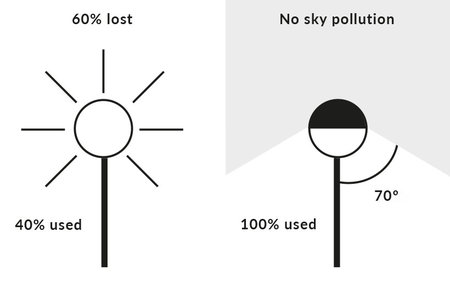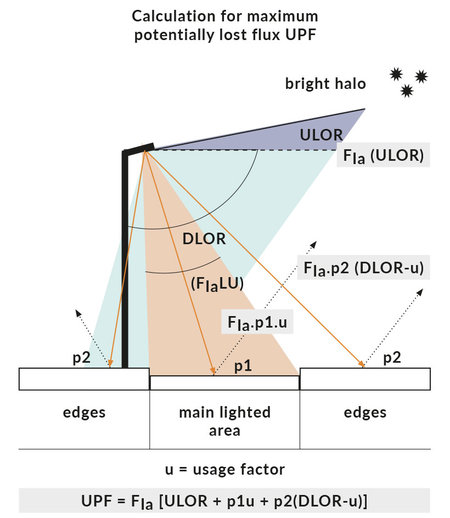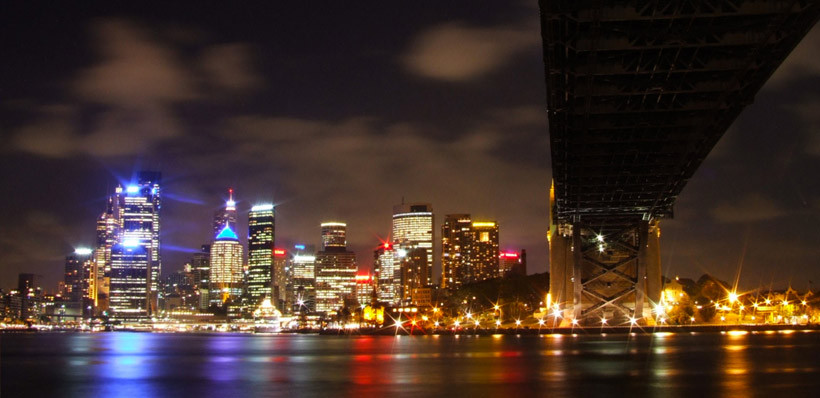Light pollution: the best solutions for outdoor lighting
Download the PDFIs outdoor lighting doomed to forever be synonymous with light pollution? Read our top tips for reducing light pollution and discover our range of sustainable lighting solutions.
Light pollution: a major concern for outdoor lighting
From simple glare to skyglow, light pollution obscures the view of the starry sky and disrupts biological rhythms, ecosystems and biodiversity.
A relatively new concept, it is only in the last decade that light pollution has truly become a major concern for public authorities and cities.
In response, projects such as RICE (Réserve internationale de ciel étoilé) have been put in place to counter the excessive use of urban lighting and help preserve the natural beauty of the night sky.
Avoiding light pollution when lighting monuments
Lighting monuments, both natural and manmade, is one of the first things that comes to mind when talking about light pollution and outdoor lighting. More and more towns and cities have taken up the practice, especially since the rise of LED technology in the late ‘80s.
But how can lighting systems be improved to reduce light pollution? The answer lies in devising a lighting master plan, which ensures that it is used in the right place, at the right time, with the appropriate intensity and with optimal beauty:
- By adapting the intensity to the monument’s characteristics. Good does not always mean bright; softer lighting often better highlights architectural details and minimises glare.
- By orientating and focusing the luminous flux. The ULOR ratio, which is the percentage of light flux emitted upwards, should be lower than 3% for practical lighting, and 20% for atmospheric lighting.
- By choosing a programmable outdoor lighting solution to prevent unnecessary waste. Lighting may be set according to the time of day or to human presence.

Appropriate and sustainable outdoor lighting minimises energy loss and light pollution.
Using smart LED outdoor lighting to minimise light pollution
Systems that use intelligent LED technology thus provide the clear answer to modern urban environments’ need for sensible lighting that reduces light pollution. LED technology:
- Enables dimming: the luminous power of LEDs can be set from 0 to 100% in accordance with the time of day. This cuts light pollution and saves energy.
- Combined with adapted optics allows lighting to be orientated and focused. LEDs minimise the maximum potentially lost luminous flux (UPF) without causing any light trespass.

A low maximum potentially lost flux (UPF) reduces light pollution caused by outdoor lighting.
- With a high CRI (colour rendering index) makes for more aesthetically pleasing lighting.
- With lower blue light helps reduce the effects of skyglow and improves star visibility in line with recommended levels. Blue light has a larger diffusion in the atmosphere than other colours and is more perceptible to the eye at night; LEDS offer the ability to pick a colour temperature that induces less light noise. .
|
Centre of RICE/PNC zone |
RICE buffer zone |
RICE Transition zone |
|
| ULOR | 0% for practical lighting and 1% for atmospheric lighting | ≤ 1% for practical lighting and 1% for atmospheric lighting |
≤ 3% for atmospheric lighting and ≤ 1% ULOR for practical lighting (LED ≤ 3%) |
| Colour temperature and blue light percentage |
≤ 2000K or ≤ 10% blue light |
≤ 3000K or ≤ 20% blue light |
≤ 3500K or ≤ 25% blue light |
The photometric characteristics recommended and enforced for lighting installed in RICE-certified areas, as the Parc National des Cévennes (PNC).
|
LAMPS |
MELATONIN PRODUCTION |
STARRY SKY VISIBILITY |
||
|
Emission percentage between 405-475 nm |
Impact on melatonin production |
Emission percentage between 475-530 nm |
Impact on starry sky visibility |
|
|
Low-pressure sodium |
0% |
Almost zero |
0% |
Almost zero |
|
1800K amber LED |
0,9% |
Very low |
0,3% |
Very low |
|
High-pressure sodium |
5,2% |
Acceptable |
5,0% |
Acceptable |
|
Low blue-wavelength ceramic HMI |
between 9 and 10% |
Average |
between 9 and 10% |
Average |
|
2700K LED |
15,2% |
High |
2,2% |
Low |
|
Fluorescent |
17,2% |
High |
9,5% |
Average |
|
Iodure métallique |
26,1% |
Very high |
7,9% |
Average |
|
LED 4000 K |
18,3% |
Very high |
13,5% |
High |
A presentation of RICE lighting: overview, solutions and implementation.
Light pollution: LEC champions sustainable development
On 8 October 2016, LEC took part in the 8th year of Le Jour de la Nuit. The aim of the event is to raise awareness of light pollution and the need to protect biodiversity. Many issues were tackled, including the question of energy waste and the sensible use of outdoor lighting.
Since the beginning, , LEC has used advances in LED technology to offer increasingly effective and eco-friendly outdoor lighting solutions. That is our vision of innovation.
Want to know more?
Take a look at LEC's products and projects.
-
Download the PDF
- Published on 04 November 2016
- Categories: Norms & Quality - Sustainable development
- Tags : CRI - energy saving - LED - light pollution - outdoor lighting - RICE - ULOR - urban lighting

